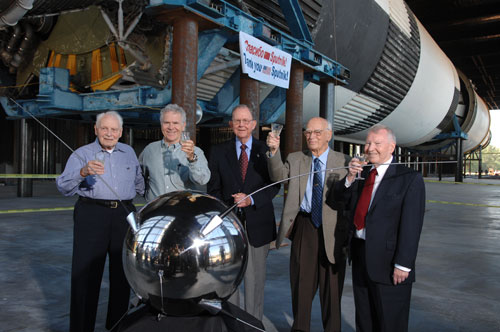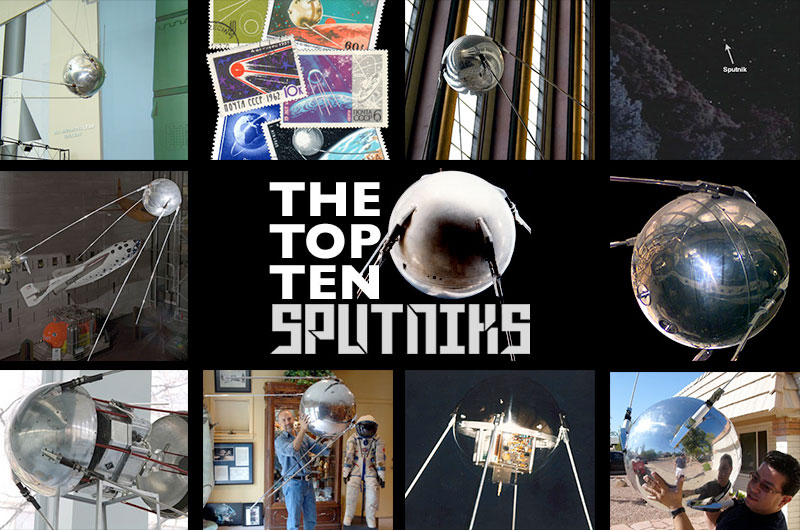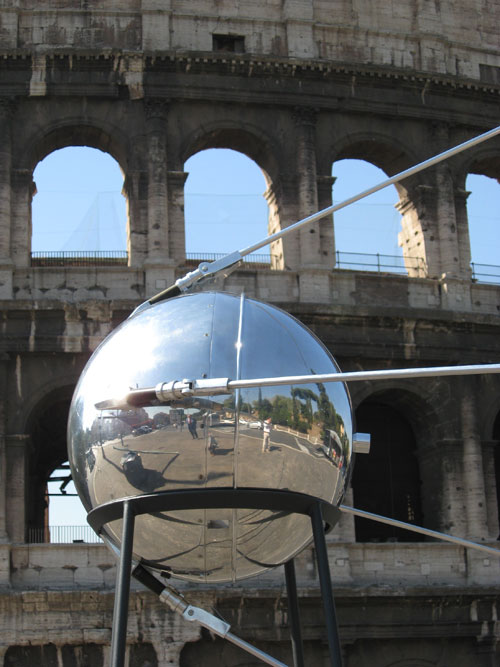At America's 'Birthplace of Space', the rocket scientists who launched America's first satellite stood beside their original Saturn V Moon Rocket for a champagne toast to Sputnik. A banner hung from the 366-foot Saturn V that said "Thank you Sputnik!" in both Russian and English.

"Sputnik was the best thing that could have happened to us," said Dr. Ernst Stuhlinger, 93, "without the 'wake-up call' from Sputnik, who knows if we would have ever gone to the moon."
The toast took place in the nearly completed Davidson Center for Space Exploration at the U.S. Space and Rocket Center in Huntsville. The Center will house the original Saturn V Moon Rocket, the 160 million horsepower behemoth that took men to the moon in 1969. The grand opening is scheduled for January 31, 2008 -- the 50th anniversary of America's first satellite launch - - Explorer 1. Leading figures and celebrities from the space race are expected to attend the space spectacular.
Homer Hickam, 64, author of "Rocket Boys" was a high school student in West Virginia when he saw Sputnik pass overhead after its Oct. 4, 1957 launch. "If it had been God in his chariot that had flown over, I could not have been more impressed," he told the New York Times. Hickam decided that night to join the space program. He joined NASA after college and had a 17-year career designing spacecraft and managing astronaut training.
Konrad Dannenberg, 95, was the oldest of the rocket pioneers in attendance. He was born in Germany in 1912, and began experimenting with rockets as a teenager in the late 1920's. "I have been a 'Rocket Boy' for almost 80 years now," he said. "Once you are a 'Rocket Boy,' you are always a 'Rocket Boy!'" In the 1960's, he became the deputy manager for the Saturn V.
The space program transformed Huntsville from a cotton town of 10,000 people to 'The Rocket City' -- a booming globally-recognized center for aerospace, defense, telecommunications and bio-tech. The area boasts the highest concentration of engineers and scientists in the country, and is a mecca for high tech start-ups.
Dr. William Lucas, 85, became the director of NASA's Marshall Space Flight Center in Huntsville for 12 years before retiring in 1986. "The Huntsville team went from putting America in space in 1958 to putting America on the moon in 1969," said Lucas. "That's an accomplishment we are all very proud of."
Huntsville's start in space began when German rocket pioneer Dr. Wernher von Braun brought his team to Huntsville in 1950. Within a few years, he became the first space "rock star," appearing on Walt Disney's television program, Collier's magazine and popularizing space. Von Braun's team worked for the Army's General John Medaris. Despite the team's expertise, they were turned down on 5 separate occasions to launch a satellite. President Eisenhower was concerned that an Army rocket might be denied the right to fly over the Soviet Union. Instead, he gave the satellite project to the civilian Vanguard program.
Once Sputnik was launched, it established the precedent of fly-over rights, and von Braun's team was finally given the green light to proceed on Nov. 8, 1957. Von Braun brashly predicted it would take 90 days to launch a satellite. Explorer 1 was launched only 84 days later on Jan. 31, 1958, and America was in the Space Race, its pride restored. Eleven years later, their Saturn V rocket put men on the moon,
Upon first hearing of Sputnik's launch, General Medaris said "Those damned bastards!" Years later he saw the value of Sputnik, "If I could get my hands on that Sputnik, I would kiss it on both cheeks!"
Like many of his future co-workers, Julian Davidson, 80, grew up in rural Alabama in a house without running water or electricity, picking cotton at a penny a pound. After World War II, the GI Bill made him first in his family to go to college. He was in the blockhouse when Explorer 1 was launched. He later became a successful rocket entrepreneur, and still runs the company he founded.
When the Saturn V facility needed two million dollars for its completion, Davidson and his wife Dorothy donated the funds. The Davidson Center for Space Exploration will be dedicated to all those scientists, engineers and technicians who worked on the Saturn V. "Four hundred thousand people worked very hard on the Saturn V, and they have never received the recognition they deserve," said Davidson.
Von Braun was philosophical on the lack of recognition the engineers received. "Compared to all the glamorous astronauts," he mused, "our Saturn V has about as much sex appeal as Lady Godiva's horse!"
The January 31st celebration will put the spotlight back on those engineers. Panel discussions and a black tie event are planned.
Stuhlinger and Dannenberg both sport Sputnik lapel pins given to them by their friend, Soviet space official Leonid Sedov, shortly after Sputnik's launch. In looking at the Sputnik replica next to the original Saturn V, Stuhlinger describes one regret, "that we never had more of an opportunity to meet with our Soviet colleagues." Until the fall of the USSR, the Russian space program was shrouded in secrecy. Indeed, even the name of the Soviet Chief Designer, Sergie Korolev, was unknown in the west until his death in 1965.
"We would have much to talk about," said Stuhlinger of his Sputnik counterparts. Event organizers now plan to invite Soviet rocket pioneers to the January 31st event.














